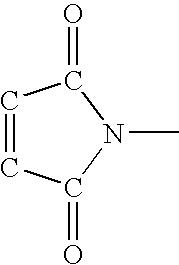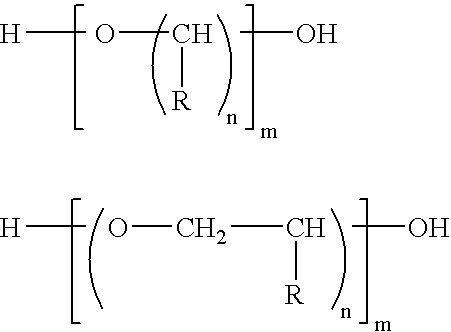Photochromic multifocal optical article
a multi-focal optical and optical article technology, applied in the field of multi-focal optical articles, can solve the problems of not readily imbibing photochromic dye/compound(s), unable to exhibit significant photochromic activity of photochromic dye/compound(s), and the inability of polymer matrices to be used as substrates for imbibed (or internally incorporated) photochromic materials for commercially acceptable photochromic optical applications
- Summary
- Abstract
- Description
- Claims
- Application Information
AI Technical Summary
Benefits of technology
Problems solved by technology
Method used
Image
Examples
example 1
[0218]Polycarbonate test lenses having base curves that matched approximately the molds used were cleaned with soap and water, dried and then treated with an oxygen plasma for 1 minute using a Plasmatech machine at a power setting of 100 Watts while introducing oxygen at a rate of 100 ml / min into the vacuum chamber of the Plasmatech machine. The lenses were then rinsed with deionized water and dried with air. A photochromic polyurethane coating composition was applied to the plasma treated lenses by spin coating (targeting a 0.22 gram wet weight) and thermally cured in an oven at 120° C. for one hour. The components of the polyurethane composition and their amounts are tabulated in Table 1. The photochromic polyurethane coating was approximately 20 microns thick. These lenses (preform) were used as one half (the rear half) of the mold set described below.
[0219]
TABLE 1Formulation(1)Component / Weight PercentTrixene 7960 (a)35.9PC 1122 (b)16.3Poly(meth)acrylic polyol (c)16.6Tinuvin 144 ...
example 2
[0226]The procedures of Example 1 were followed except that the optical resin composition comprised 70 weight percent of PRO-6169 dendritic polyester acrylate, 10 weight percent of DMP blocked isocyanatoethyl methacrylate, 10 weight percent of hydroxyethyl acrylate and 0.2 weight percent of Irgacure 819. PRO-6169 is reported by its supplier to be a dendritic polyester acrylate prepared by acrylating a polyester polyol having 16 terminal hydroxyl groups, of which approximately 85 to 90 percent on average are converted to acrylate groups. The PRO-6169 material is reported to have a number average molecular weight of 700 and a weight average molecular weight of 3000. In this example, two 2.00 base curve test lenses were used.
[0227]The test lenses were tested for adhesion and observed for optical cosmetic imperfections, particularly at the multifocal segment(s). Adhesion of the multifocal resin layer to the preform was tested by use of the standard cross hatch tape pull test. Based on t...
example 3
[0229]The procedure of Example 1 was followed except that the multifocal resin was prepared from a composition comprising 90% of NXT 7022 dendritic methacrylate, 10% DMP blocked isocyanatoethyl methacrylate and 0.3% of Irgacure 819, and lenses having 2.00, 6.00 and 8.00 base curves were used. The multifocal lenses prepared with the 6.00 and 8.00 base curve lenses had acceptable cosmetics.
PUM
| Property | Measurement | Unit |
|---|---|---|
| refractive index | aaaaa | aaaaa |
| degree of crosslinking | aaaaa | aaaaa |
| degree of crosslinking | aaaaa | aaaaa |
Abstract
Description
Claims
Application Information
 Login to View More
Login to View More - R&D
- Intellectual Property
- Life Sciences
- Materials
- Tech Scout
- Unparalleled Data Quality
- Higher Quality Content
- 60% Fewer Hallucinations
Browse by: Latest US Patents, China's latest patents, Technical Efficacy Thesaurus, Application Domain, Technology Topic, Popular Technical Reports.
© 2025 PatSnap. All rights reserved.Legal|Privacy policy|Modern Slavery Act Transparency Statement|Sitemap|About US| Contact US: help@patsnap.com



